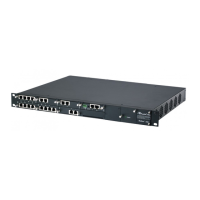SIP User's Manual 246 Document #: LTRT-83310
Mediant 600 & Mediant 1000
SIP Response Description
ISDN Release
Reason
Description
500 Server internal error 41 Temporary failure
501 Not implemented 38 Network out of order
502 Bad gateway 38 Network out of order
503 Service unavailable 41 Temporary failure
504 Server timeout 102 Recovery on timer expiry
505* Version not supported 127 Interworking
600 Busy everywhere 17 User busy
603 Decline 21 Call rejected
604 Does not exist anywhere 1 Unallocated number
606* Not acceptable 38 Network out of order
* Messages and responses were created because the ‘ISUP to SIP Mapping’ draft does
not specify their cause code mapping.
18.1.6.2 ISDN Overlap Dialing
Overlap dialing is a dialing scheme used by several ISDN variants to send and/or receive
called number digits one after the other (or several at a time). This is in contrast to en-bloc
dialing in which a complete number is sent in one message. ISDN overlap dialing is
applicaable to PRI and BRI.
The device supports the following ISDN overlap dialing methods:
Collects ISDN called party number digits and then sends the SIP INVITE to the IP side
with the complete destination number (see 'Collecting ISDN Digits and Sending
Complete Number in SIP' on page 246)
Interworks ISDN overlap dialing with SIP, according to RFC 3578 (see 'Interworking
ISDN Overlap Dialing with SIP According to RFC 3578' on page 247)
18.1.6.2.1 Collecting ISDN Digits and Sending Complete Number in SIP
The device can support an overlap dialing mode whereby the device collects the called
party number digits from ISDN Q.931 Information messages or DTMF signals, and then
sends a SIP INVITE message to the IP side containing the complete destination number.
ISDN overlap dialing for incoming ISDN calls can be configured for the entire device or per
E1/T1 trunk. This is configured using the global, ISDNRxOverlap parameter or the
ISDNRxOverlap_x parameter (where x denotes the trunk number), respectively.
By default (see the ISDNINCallsBehavior parameter), the device plays a dial tone to the
ISDN user side when it receives an empty called number from the ISDN. In this scenario,
the device includes the Progress Indicator in the SetupAck ISDN message that it sends to
the ISDN side.
The device can also mute in-band DTMF detection until it receives the complete
destination number from the ISDN. This is configured using the MuteDTMFInOverlap
parameter. The Information digits can be sent in-band in the voice stream, or out-of-band
using Q.931 Information messages. If Q.931 Information messages are used, the DTMF in-
band detector must be disabled. Note that when at least one digit is received in the ISDN
Setup message, the device stops playing a dial tone.

